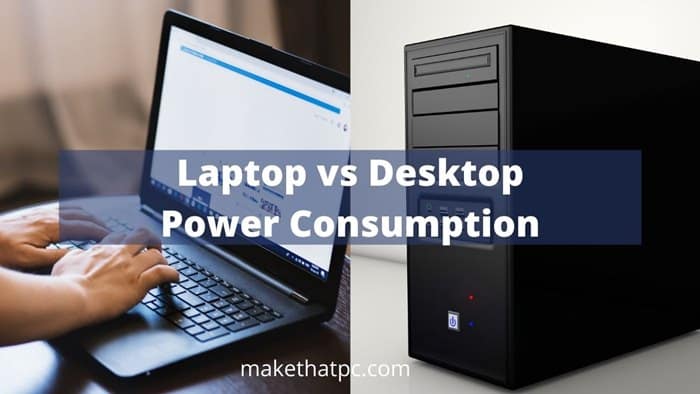Gaming can be an expensive hobby, especially if you are a professional gamer. Apart from a gaming rig, you need many more components such as headsets, an ergonomic chair, and ambient lighting to suit the mood.
Gaming laptops consume between 30-180 watts, whereas gaming desktops consume about 200-1000 watts, based on their unique features. The two main power-consuming components in your laptop/desktop are CPU and GPU. So, the more powerful CPU and GPU you have in your system, the higher will be its power requirements. However, these numbers are not going to be constant. The power consumption will increase only when you are putting a load on your system. In idle situations, the power consumption will be very minimal, especially in laptops.
Laptops generally consume less power because they are built using a smaller size of components. You will see that the motherboard, CPU, GPU, and RAM are designed in smaller form factors for laptops as compared to desktops.
Laptops are not designed for very high performance as desktops can do. Desktops generate a lot of heat as compared to laptops and this is another reason for higher power consumption.

What Are The Factors That Affect Power Consumption?
There are a lot of factors that can cause your energy bills to shoot up. Some of these factors are:
1. GPU
The more powerful a GPU is, the more electricity it consumes. This is because games or software with higher graphics resolutions require more energy. As a result, GPUs with advanced hardware, such as the RTX 2080, 2070, or 2060, are utilized in most machine learning and data science laptops and workstations.
The dedicated graphics cards such as Radeon RX 6800XT, 6900 XT, RTX 3080, or RTX 3090 can consume more than 300W of power. However, the graphics cards inside the laptops are smaller in size and generally consume a way lesser amount of power.
For example, the RTX 3080 inside a laptop consumes around 130 Watts of power whereas the same graphics card is designed for a desktop with 338 Watts of power.
2. CPU
The CPU is the brain of the computer or laptop. The CPU is responsible for comprehending your actions and executing them in reality. Regardless of what you do on your gaming laptop or desktop, the CPU remains in the picture. The latest technological advancements ensure that the newest CPUs are more energy-efficient than their predecessors. Not only do they consume less energy, but they also offer improved performance.
Again, the CPUs inside the desktops have a bigger form factor as compared to the desktop CPUs.
Just take another example here. Intel’s most powerful, Core series, Desktop CPU i9 12900K consumes around 240 Watts of power. Whereas, the Core i9 12900HK (Mobile CPU) consumes 115 Watts at maximum turbo power.
So, there is a huge difference between the power consumption of laptop CPUs and Desktop CPUs.
3. RAM
The RAM consumes a lot of electricity based on the number of applications it is running at any given moment. Consider launching the task manager and kill the apps that are irrelevant to you. This can considerably help in lowering power consumption.
The laptops use SO-DIMM memory modules which are smaller in size as compared to desktop’s DIMM memory modules. But, there is no huge difference in power consumption. Both of them will not consume more than 5 Watts even while working to their fullest.
4. Power Adapter
Power adapters are the source from which your device powers up. The more powerful your rig + the more peripherals you connect to it, the higher the electricity consumption will be. As a result, you will need a power adapter that ensures an uninterrupted power supply.
5. Screen Resolution
The screen resolution of the gaming laptop or desktop directly influences how much watts are consumed. Therefore, choose a gaming laptop with an appropriate screen resolution if you are on a budget. The latest gaming rigs come with screen resolutions ranging from 1080p HD to 8K quality.
6. Poor Quality Components
To save money, manufacturers will sometimes employ the use of lower-quality components. They may, for example, utilize thermal pastes that may not hold up well over time. As a result, your PC may become hotter as the paste deteriorates, resulting in stuttering and forced cooling, consuming more energy.
7. Outdated Tech
Outdated tech is less efficient compared to the latest systems. Newer technologies provide better results while optimizing energy consumption levels. In comparison, outdated tech gives you neither.
8. Heavy Software
Heavy software requires the device to work double-time as it needs extra resources to keep all functions running without hiccups. The gaming laptop may pull in 120-330 watts per hour in this scenario.
9. Dust
Like anywhere else, dust finds its way into the inner cores of the heat sink too. This can cause it to clog and ultimately overheat the device. In addition, when the cooling fan works harder, the more energy it requires.
If you use a gaming laptop, you must call a technician to clean your device internally. However, if you have a gaming desktop, you can clean the system by taking it apart once the device is disconnected from the grid.
Save Electricity: Tweak Some Settings
Regardless of whether you are gaming on a laptop or a desktop, you can implement a few methods to reduce your energy consumption. For example, gaming laptops require up to 300 watts of electricity per hour.
Gaming laptops consume less electricity since they are powered by a battery and do not require an external uninterrupted power source. Gaming desktop users can follow these steps to reduce the energy consumption levels on their device:
- Tweak the power settings and activate ‘Sleep Mode’. When you are not gaming, the device will consume lesser electricity than leaving the desktop in ‘Idle Mode’.
- Verify if your desktop monitors have an ‘Eco mode’.
- Suppose you an air conditioner while gaming; set it to 24 degrees so that the device does not overheat. This can have a significant impact on your energy bills.
- Dump the standard heat-generating bulbs and switch to LED light bulbs.
- Change settings to turn off the display fast
Conclusion
Changing a few settings within the laptop, desktop, and the environment makes it possible to reduce energy consumption levels. In addition, we recommend upgrading to the latest components as they are more energy-efficient as well.

I am Anshul Rana, an experienced author specializing in PC gear reviews and Windows 10 software tutorials. With a strong passion for technology and an in-depth understanding of the PC industry, I provide insightful and detailed analyses of computer peripherals, gaming gear, and software solutions. My writing style is concise yet informative, making complex topics accessible to both beginners and advanced users. Through my reviews and tutorials, I aim to offer valuable guidance, helping readers make informed decisions to enhance their PC experience and explore the vast possibilities of Windows 10 software.









